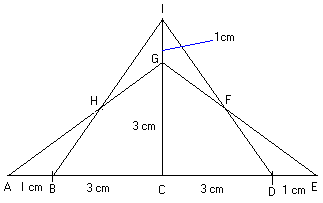Copyright © University of Cambridge. All rights reserved.
'Isosceles' printed from https://nrich.maths.org/
Show menu
From the diagram sent in by Chin Siang, Tao Nan School, Singapore, you can see that triangles AEG and BDI are equal in area because each is made up of two right angles triangles with sides 3, 4 and 5 units with the line IC as an axis of symmetry:

Suzanne and Bethany (the Mount School, York) sent us this solution:
Any isosceles triangle with base b , height h and area bh /2 can be split into two right angled triangles along the axis of symmetry and these right angled triangles can be re-assembled into a second isosceles triangle with base 2 h , height b /2 and area bh /2. The only case in which the pair of isosceles triangles are congruent is where b = 2 h so there are infinitely many pairs of non congruent isosceles triangles with the same area. In general the sides are not of integer length but there are also infinitely many such pairs with sides of integer length formed from right angled in which the lengths of the sides are Pythagorean triples. For example the two isosceles triangles with sides 13,13, and 10 units and with sides 13,13, and 24 units both have area 60 square units.
The Pythagorean triple 7, 24, 25 gives triangles with sides 25, 25, 14 and 25, 25, 48 which both have areas of 168 square units, and we can go on doing this with Pythagorean triples of which there are lots. As for isosceles triangles with an area of 12 square units, well it only needs the base and height to have a product of 24, so, if we insist on whole numbered sides, then there are only two - the ones given. If sides do not have to be whole numbers then there are an infinite number of solutions, though some would be difficult to tell apart.